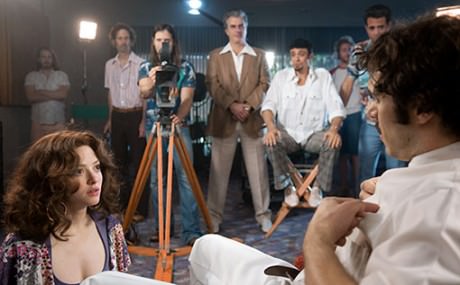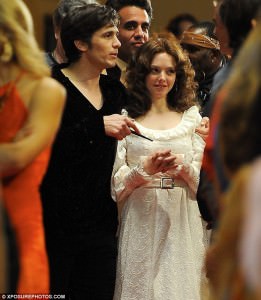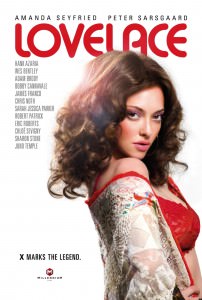In 1972 some men made a film that did her wrong. Unspeakably and indelibly wrong. The film was named Deep Throat. Now some men—with two women producers—have made a film that does right by her. It’s called simply Lovelace. And cinematic justice has never been so bittersweet.
“Linda Lovelace” was the nom du porn of Linda née Boreman (played luminously by Amanda Seyfried), who as a 21-year-old naif was seduced by a lowlife, snaky charmer named Chuck Traynor (played with alarming menace by Peter Sarsgaard). Theirs was not a love story.

After tricking Linda’s parents (played with poignant depth by Sharon Stone and Robert Patrick) into trusting him, Traynor marries her. Early on he gets arrested and jailed and phones her to bail him out. She never knows what exactly he does for “work” (he’s a pimp); he forbids her to ask him—and pointedly he tells her that a wife cannot testify against her husband. His Svengalian grip on her tightens. He hypnotizes her into ultimate fellatio, beats her, rapes her, pistol-whips her, and peddles her to sleazeballs (played with creepy cred by Chris Noth, Bobby Cannavale, and Hank Azaria), who make the movie that made them gazillions from her suppressed gag reflex.

There have been a few other fine films that have depicted with fearsome veracity men’s controlling violence toward women. What’s Love Got to Do With It (1993), based on Ike Turner’s abuse of Tina, comes to mind. I recall seeing that fiery film in a crowded theater in DC with a predominantly black audience who voluably warned the onscreen Tina (the awesome Angela Bassett) to get the hell out.
Another classic of the genre is Enough (2002), about an abused wife who learns to fight back. It starred Jennifer Lopez in a gut-wrenching performance—perhaps her best screen acting ever. And of course The Accused (1988) belongs on the list. Based on a real-life gang rape and subsequent trial, it starred Jodie Foster in a shattering performance that more than earned her a Best Actress Oscar.
These films are all well and good—but the real money to be made from movies about men’s controlling violence toward women is if the flick gets off dicks. I refer, of course, to pornography. And that’s where Deep Throat came on the scene. It became a chic hit. Esteemed critics such as Norah Ephron and Roger Ebert praised it. Johnny Carson cracked jokes about it. At the time, nobody seemed to notice the bruises that were evident in the film on Linda Lovelace’s body. Nobody seemed to wonder how in the world those bruises got there. Lovelace goes behind the scenes and shows how they got there: Chuck Traynor was beating the crap out of her. For anyone who ever watched Deep Throat in a reverie of sexual release, Lovelace will come as more of a shock than a hypothermic shower. For anyone trapped in a cycle of domestic violence and/or the sex industry, Lovelace will be a signal that there’s an exit. For not only does Lovelace warrant serious awards attention and audience admiration on its filmmaking merits; Lovelace so illuminates the dark side of pornmaking that it’s as if the movie theater’s projection booth has become a lighthouse beacon for saving lives.
The film’s structure is brilliant. The directing team of Rob Epstein and Jeffrey Friedman, who with Andy Bellin wrote the taut and evocative screenplay, created their own new form with which to tell Linda’s story: They used as their point of dramatic departure how Linda’s psychological perspective shifted as her troubles deepened. I personally found it helpful to know about their framework ahead of time, because it made the film’s steadily building tension palpable from the start. But I can readily imagine that for anyone with no foreknowledge of Deep Throat’s true back story, not knowing what to expect heightens the impact of the dramatic reversal to come. First we see the story of Linda’s romance with Traynor and a vision of the making of Deep Throat as if through rose-colored glasses. Jump-cut six years later to a scene where Linda is taking a lie detector test at the behest of the publisher of her autobiography Ordeal, in which she tells what really happened to her. Then the movie backs up and replays the same story but this time with its harsh reality raw—all the beating and prostituting and gang-raping behind the porny fantasy exposed.
Well, not all of it. I’ve read Ordeal. The movie makers left out the worst of what was done to Linda, which was abominable and included forced bestiality. Had they not, I have no doubt, Lovelace would have been not only unreleasable but unwatchable.
But be assured, these movie makers evidence a deeply sensitive intuition about their audience’s sensibility. The camera pulls back, or there’s a quick cutaway, from each instant or event that might so disturb us that it would distract us from the emotional throughline of Linda’s story. This holds true for the sex scenes as well as the violence. The result is that much of this material happens in our mind’s eye, not onscreen.
Plus there’s the absolutely luminescent performance of Amanda Seyfried. If you’ve seen and loved her in, say, Mamma Mia! or Les Misérables (as I have), you will be blown away by the emotional insight she brings to the screen in Lovelace. There is a whole movie going on in her eyes. And it is a wonder to behold.
Co-directors Rob Epstein and Jeffrey Friedman have given us Milk (about assassinated gay icon Harvey Milk), The Celluloid Closet (a documentary about gays in film), and HOWL (starring James Franco as influential gay poet Allen Ginsberg). So it should come as no news that Epstein and Friedman are themselves gay. But the really big surprise here is that these two gay men have made in Lovelace a movie that exposes the abusiveness of heterosexual pornography. Not only that, but they depicted sexual abuse of a woman without ever treating it as a turn-on—something rare in movies by straight men.

If I have a quibble with Lovelace, it’s that James Franco—a wonderful actor elsewhere—was totally miscast as Hugh Hefner (an embarrassingly awkward portrayal so airbrushed it bore no resemblance to what Linda disclosed about Hef in Ordeal). And if the roseate opening scenes, which include cheesy gag lines from Deep Throat, do not tickle one’s taste for a cheap tease, they could leave a viewer slightly impatient. Unless one limns what dire darkness lies ahead, the going could seem uncertain.
There’s clear dramatic purpose underway, of course, and the filmmakers stay true to it with a sure hand and their smart bait-and-switch structure. By midway through, as one screw after another is turned, the mounting tension becomes nearly overwhelming. Thus the scenes near the end of resistance, recovery, and reconciliation prompt an extraordinary sort of catharsis: It is, ironically, the kind of confrontation with emotional truth and political reality that sometimes happens best in what seems fiction.
Running Time: 92 minutes.
Lovelace opened yesterday nationally but at a paltry few theaters nearby: AMC Rio in Gaithersburg, AFI Silver Theatre in Silver Spring, and the Angelika in Fairfax. Check the showtimes here.
(Why it’s not in the District at the Landmark E Street Cinema is incomprehensible to me). Lovelace is also available via on-demand channels and iTunes.
https://youtu.be/KaVDYnIh-Zo






An exceptional review that is right on point!! Thank you, John, for “getting it”…..which obviously comes from your more comprehensive understanding of the subject matter and personal connection to Linda. Having worked on Lovelace, the greatest challenge was finding a structure that would keep the audience in their seats. If we had revealed chronologically the violence in her story (as it was written by Linda in Ordeal), the vast audience would have reject it. Her story was a very dark one….but Linda’s true legacy was to shed light on how the porn industry can prosper on human trafficking and domestic violence at a time when there was little attention to these social injustices.
I look forward to reading more of your enlightened blogs in the future!